Improving Terrestrial Ecosystem Models
Terrestrial Ecosystem Models, or TEMs, simulate the exchange of heat, momentum, water, carbon, etc. between the soil, plants, trees and the surrounding atmosphere. Like other models, TEMs are imperfect, but scientists continuously strive to improve their accuracy. During the CAMELS project, the Max Planck Institute of Biochemistry teamed up with the UK Met Office and Le Laboratoire des Sciences du Climat et l'Environnement (LSCE) to apply new techniques in TEM validation. More specifically, they inverted TEM variables against measurements of the Net Ecosystem Exchange (NEE) of carbon dioxide (CO2) and the latent heat flux (LE). The Biosphere Energy-Transfer and Hydrology Model (BETHY) and Organizing Carbon and Hydrology in Dynamic Ecosystems (ORCHIDEE) TEMs were employed. Sensitivity experiments were performed in order to test the assumptions that were required for the inversion procedure. The CAMELS group learned that careful selection of high quality, representative data produced the best results. However, the reproduction of some seasonal cycle and phenology parameters was still less than optimal. They recommended that a sufficient number of monitoring sites be used per plant type in order to avoid misleading results. In general, following some tweaking, the inversion technique led to greater agreement between TEM output and observations. Some weaknesses were identified, such as the ORCHIDEE's inability to account for the effects of extreme hydrological events, such as droughts. The CAMELS modellers are working to update the TEMS to address these flaws.







